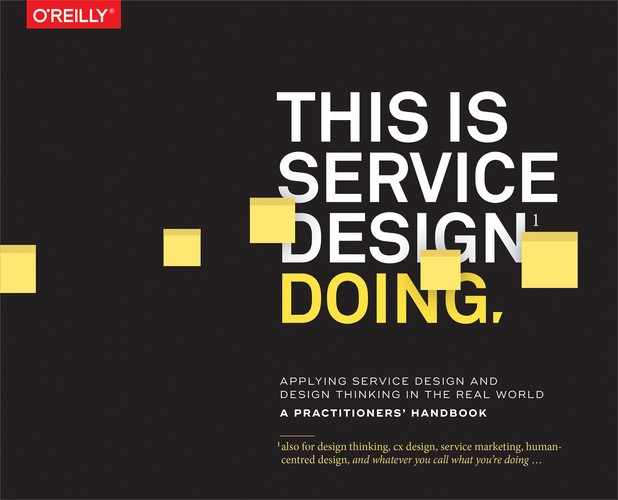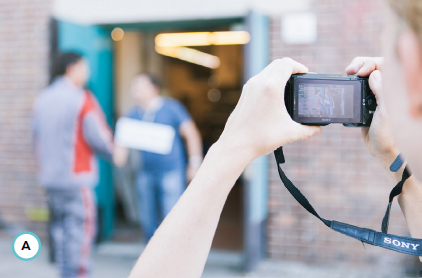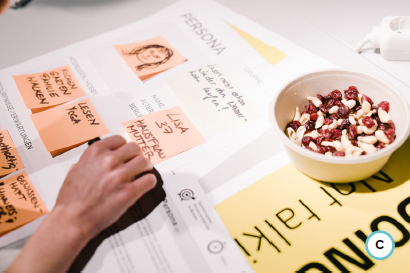Chapter 8. Implementation
Service design should not end with a concept or a prototype. The aim must be to have an impact on people, organizations, and the bottom line.
Expert contributions and comments:
Erich Pichler | Jürgen Tanghe | Julia Jonas | Kathrin Möslein | Klaus Schwarzenberger | Minka Frackenpohl | Patricia Stark
This chapter also includes
The Sharp End of Service Design
Implementation – turning a prototype into a running system – is the sharp end of service design. Some commentators have criticized service design for being weak at implementation, and it is easy to understand these objections.
 Comment
Comment
“To provide solutions, firms need to create service systems composed of physical components, technology, and data, including knowledge, communication channels, and networked actors. This equally applies to service systems in manufacturing, healthcare, energy, or security and has been promoted especially in the context of the Internet of Things.”
— Kathrin Möslein
Many early service designers came from graphic or product design where, if they kept within set technical parameters, the realities of production did not concern them much. Or clients did not include implementation in the scope of the project, even if the designers wanted to address it. Perhaps because of this background, their mode of working might have been uncharitably perceived as: “Here is your design and an invoice, good luck making it happen.”
Service design today is different. Service designers are invited to support projects end-to-end and a growing number of implementation projects even adopt a service design approach to replace their traditional project management methodologies from start to finish.
In any case, if our goal is to create a change which affects end customers, employees, processes, and even the business model, implementation always must be an indispensable core part of our work.
From Prototype to Production
What is implementation?
Implementation describes the step beyond experimenting and testing, to production and rollout. The implementation of service design projects can involve various skill sets, such as change management for organizational procedures and processes (including training, coaching, recruitment), software development or engineering for the production of physical objects, but also architecture and construction management for the creation of environments and buildings. Despite the different contexts, there are several similarities between these fields of implementation.
 Comment
Comment
“Cost and sales supervision, resource planning, and similar topics related to facts and figures are a crucial element of service implementation.”
— Julia Jonas
The boundaries between prototyping, piloting, and implementation are fluid. Full implementation might need us to initiate a large technical process, even refit a production line – steps which are very expensive to change later. Or implementation might just be a case of a handful of people doing their jobs differently. Whatever the scale of the change, there are some common patterns as we move into “everyday business”:
→ Switching to production systems
New services or new products, 1 whether physical or digital, run within the real context, in a given environment and system.
→ Working with actual employees
Employees that were not involved in the service design process now have to execute new processes, even though they might not truly believe in them.
→ Main focus on business goals
Services and physical or digital products are sold at full price. The main focus shifts toward core business goals and away from innovation.
→ Integration into existing (eco)systems
The services or products, whether physical or digital, are embedded into existing (legacy) IT systems, environments, and legal frameworks, as well as functioning partner networks and (eco)systems.
→ Integration into existing KPI frameworks
New business metrics are integrated into existing and regularly monitored KPI frameworks.
→ “Business as usual”
The customer no longer perceives the offering as beta. Employees no longer perceive it as pilot.
→ Iterations/changes/adaptations get more expensive
As we progress toward implementation changes become increasingly difficult and expensive. Therefore, organizations tend to avoid changes at this stage.
Planning for human-centered implementation
It is often valuable to consider your implementation activities as a separate project within your service design project. In this implementation project you need to consider frontline and backstage staff, and all implementation partners, as your primary target audience. Think about:
→ Research
Who is or needs to be involved? What will the rollout/implementation experience look like? What are key obstacles or needs that need to be addressed?
→ Ideation
How might you create a great implementation or rollout experience? How might you effectively build the final offering? How might you scale?
→ Prototyping
How can you build a pilot – a working prototype of your implementation? How can you use prototyping to create a great implementation experience (rollout, launch) for your employees, customers, and partners?
→ Implementation
Based on the learnings from your prototypes and pilots, how are you now building, launching, and rolling out your final offerings (a unique mix of services, physical products, and digital products)?
Four fields of implementation
Implementation needs to vary from project to project. To reflect this, and to make principles and methods of implementation in various fields more tangible, in the following sections, four guest authors describe how service design can connect with four specific fields of implementation:
8.2 Service design and change management How to implement new concepts and make lasting behavioral change happen in organizations
8.3 Service design and software development How to give a common language to your development team, connect them to user needs, and answer the questions of what we should actually build and how it should be prioritized.
8.4 Service design and product management How to integrate service design with product development and product management to balance UX, technology, and business requirements, and how to implement the value proposition of your product and service portfolio across the whole product lifecycle.
8.5 Service design and architecture How to identify user needs related to people using space, co-create through prototyping with the later users, and enrich the architectural practice with approaches and tools from service design.
Service Design and Change Management
AUTHOR
Jürgen Tanghe
Some service designers consider their work done once they have proposed a new concept, in the form of a management pitch, a service blueprint, or a (working, functioning) prototype. They fail to fulfill the last phase of the service design process. This situation is akin to a product designer designing the most beautiful, ergonomic, functional, and ecological chair …then failing to produce it.
Artifacts of services come in a variety of forms, including physical, like a document or check-in desk, and digital, like a website or app. Also, in most services there is a human interaction element that is the essence of service: someone (the service provider) helping somebody (the customer) to achieve something.
This means the organization and the people in the organization become the “material” you are producing the service with. This section will help you work with this them to get your design fully implemented. 3
Design involves desired behavior
Explicitly or implicitly, a designed service always involves establishing a desired way for both the customer and the service provider to behave. Therein lies the challenge for change management in service design. How can we make people change their behavior, so that it is beneficial for the customer experience? Many traditional banks are redesigning their retail experience, for example, by creating a more open layout. But this only works when bank employees also change – they need to be more hosts than bankers, more advisors than tellers.
Know how people change
The reality is that organizations themselves don’t change; only people do, and ideally an organization supports that behavior. This means that the only real measure of change is: “Do people act differently?”
Be change
While many claim that people hate change (“the only person who likes change is a baby with a wet diaper”), the truth is more complex. People change constantly, and they love some changes. Oftentimes, people are even willing to make big life changes to meet a goal, such as relocating to work for a particular employer.
You can’t change people: Set up the context for change instead
Behavioral change is both simple and complex. On the one hand, people change all their lives, all the time – it is a rather natural activity. On the other hand, deliberately changing can be difficult, even if the stakes are really high. Just look at how difficult it is for people to adopt a healthy lifestyle even if they really want to or when their lives are at risk.
The probability of people changing their behavior depends on three factors: (1) how much they understand that they must change, (2) how much they want to change, and (3) how much they can change. In other words: MUST*WANT*CAN or Drive*Motivation*Ability. These three factors hold the ingredients to make individual, lasting behavioral change in organizations happen.
With this formula in hand we can draw up the circumstances and context that give people the biggest chance of changing their behavior in a way that is beneficial for the service. Chances of success are biggest if we can:
→ Start with motivation.
→ Do one small, specific, but significant thing differently.
→ Adapt the environment to make it as easy as possible.
→ Establish a relationship with a group of people accustomed to that behavior.
→ Grow from there to a new definition of your identity.
Understanding what will change
Before you can make any form of change strategy, you need to understand the consequences of the new service to the organization. What will need to work differently in the organization for the service to become real?
One classic and easy-to-apply analysis framework is Leavitt’s Diamond, a model that is composed of four elements: task, people, technology, and structure. In essence, this model proposes that for an organization to be successful, the four elements need to be aligned and balanced. Imagine you have a sandwich bar, serving fresh, made-to-order sandwiches:
→ Task: This describes what the staff is expected to do. What is the job of each of the roles? In the sandwich bar, you might have someone to take orders, somebody to make the sandwiches, and somebody to collect the money.
→ People: Think about the people you need in your organization. What knowledge and skills do they need, and do they require any formal training or education? How many people do you need?
→ Structure: Structure is about how the organization is organized. This includes how departments are structured, but also what is measured and monitored, and how decisions and made? To be efficient, you could imagine that the decision rules would be flexible enough to allow staff to accommodate special requests for a sandwich that isn’t listed on the menu (if the bar has the necessary ingredients) – staff shouldn’t need to ask for permission to do this. Also, you will probably have some kind of monitoring system to assess customer satisfaction, the freshness of the food, and maybe the success of the daily specials.
→ Technology: These are all the tools, digital and analog, that are needed for the staff to perform their tasks efficiently and effectively. In our sandwich shop, this would include a decent knife and a cash register, but also maybe a checklist with instructions for how to make that daily special.
As a service designer, you can use this framework in multiple ways. First, you can see if you have thought of all the aspects of the service system. Second, any change introduced to the organization will impact one or more of these four elements; you can use this framework to map them, and thus to manage all of those potential impacts.
There are several ways to do this impact analysis. However, it is always important to involve the people who can judge the impact, because they know the current status. You can do this type of impact analysis:
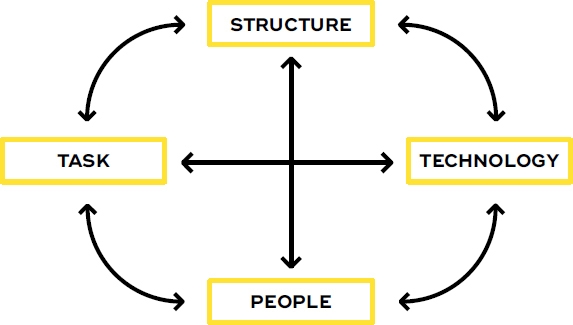
Figure 8-1. Leavitt’s Diamond: an analysis framework to understand elements of change
As a checklist for yourself Of course, you can just go over your concept and reflect on the impact on the different elements. This might work if you know the organization really well.
Based on a service blueprint If you are accustomed to working with a service blueprint, it is a good basis for an impact analysis. Look at all the staff actions, and assess how they will be different from now, what support the staff will need, and what could go wrong. With the right people in the room, this is an interesting use of a blueprint in a workshop.
Using interviews Based on the model, you can ask people what they think the impact would be. It is essential that they understand the concept well to make that judgment.
As part of prototyping and testing You can integrate this model into your evaluation routines when prototyping and testing. In that way, you can not only test the desirability but also the feasibility of your prototype, and let it evolve to more fidelity.
Beliefs and emotions
There are two more things you should remember about change. First, for a long time we thought that the key to getting people to change was answering “What’s in it for me?”
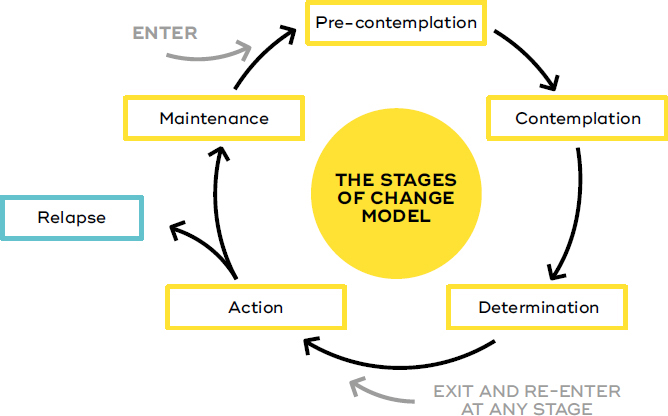
Figure 8-2. A simple model of the stages of change
This not only is a very transactional way of looking at people, but has also been proven to be wrong. Actually, once you can establish the need for change and a minimal level of motivation, the most important question that peo ple have is “How can I do this? How can I be good at it?”
The psychologists Carlo DiClemente and James Prochaska developed the transtheoretical model (TTM) of behavioral change. As the graphic shows, most of the steps are related to the belief that you are able to make the change.
Second, we need to remember the power of emotions. Emotions are the biggest driver of behavior; that is where the energy comes from and that is where action starts. It can be very hard, or nearly impossible, to convince people to take action or change based on pure rational arguments. One of the strengths of designers and design thinkers is being in contact with the emotions of people in an organization, and this strength should be utilized in change management efforts.
Based on this knowledge, there are three key tactics that are very powerful to both deal with organizational impact and support behavioral change: 4
1 Use a human-centered and stakeholder-focused approach
Just as you would do a stakeholder map of the service environment, it is essential early in the project to map the internal stakeholders. You can use Leavitt’s Diamond to get more richness in the descriptions of your stakeholders’ organizational positions. Also, use the same empathy you used toward the customers to really understand your stakeholders. There is a lot of writing about “resistance to change” or “unwillingness.” Sometimes there is a real resistance or unwillingness because of a political agenda or personal ambitions, but in many cases people have (from their perspective) very good and valid reasons to oppose changes that others are trying to impose on them. You can find those reasons, if you are willing to use your empathy.
2 Participation and co-creation
Working co-creatively is one of the key principles of service design. Not coincidentally, participation in decision making has been proven to be essential in change management because basically there is a reverse correlation: high participation leads to low resistance; low participation leads to high resistance. This means you should see co-creation as part of both the creation and the implementation process; in addition, you should make deliberate use of those co-creative sessions to prepare the organization for implementation. One of the challenges is scaling. You cannot invite the whole organization to join a co-creation session, so you need to help the participants use their experiences within their own teams. You might also want to run more sessions than might be strictly necessary for your design process.
3 (Visual) storytelling
For all the ingredients that support change – transferring a sense of necessity, creating emotional appeal, giving instructions on what is the right thing to do – there is a method that people have been using since the beginning of human development. That is the power of the story. Stories and the heroes in them are also one of the basic elements of an organizational culture.

Figure 8-3. The transtheoretical model (TTM) of behavioral change, developed by psychologists Carlo DiClemente and James Prochaska
Service Design and Software Development
AUTHOR
Klaus Schwarzenberger
How to create and maintain a meaningful development backlog
In this section we will explore how to connect service design methods with popular agile approaches in software development and engineering. Service design helps answer one of the most challenging questions at hand: what should we actually build and how should it be prioritized? As most agile methods today focus on the engineering team and the actual implementation, it’s service design that helps to fill the backlogs with meaningful stories.
Today, almost all customer experiences include a digital experience at some point. The hard part is to harness those different channels and technologies and build a product or service that actually serves the customer’s needs. Quite often, utilizing technology of all kinds makes stuff harder to use. Take, for instance, the early days of “car apps” that enabled you to open your car without a key. Instead of just pressing a button on the key (one step), users had to get out their phones, unlock them, open the app, and press a button (four steps) to achieve the same thing. This system had other flaws too: what are users supposed to do when their phones run out of battery, for example? The same applies to the Internet of Things (IoT) and connected devices. It’s a cool thing if you are able to turn on a light with your phone, but again, an empty battery or broken phone can make the whole thing useless.
Because services and software are intangible and often inherently complex, it is crucial to make sure that all stakeholders are on the same page and involved in the process right from the start. If this principle were boiled down it would be: seeing is believing. Everybody in the team must do user research. To fully understand the customer’s needs and provide a suitable solution, user stories, roadmaps, and fancy descriptions are not enough.
The alternative can be as easy as adding your lead developers and designers to the support email channel to make sure they see where customers get stuck. On top of that, empower them to actually make decisions based on their research results, and feature discussions will change immediately.
Basic factors
There are some basic “hygiene factors” that should be considered before you start applying a service design process to software projects. Some of them are technical, but most are more “people stuff.”
We won’t go into too much detail when it comes to the technical bits, since they may differ from industry to industry.
Agile
In software engineering the rise of Agile started in 2001, when Kent Beck et al. released the Agile Manifesto. 5 But before that, the CHAOS Report, 6 initially published by the Standish Group in 1994, brought awareness of failed projects in software development. The problem was that the same project management approaches that worked in the construction industry were used for software projects, but the complexity and changing requirements made a mess of things.
Instead of trying to plan ahead (and constantly rewriting the script as unexpected developments arise), the Agile Manifesto was a starting point for a different approach. Different methods, like Scrum, XP, ASD, Crystal, and APM, arose. Over the last couple of years most companies have followed one or a combination of these approaches with different levels of rigor. Everybody tweaked the methods to their needs, but no one admitted that they had “their own” system.
In 2015 Andy Hunt introduced the GROWS Method, 7 which actually boiled down all the different agile methodologies to their core principles. It’s a set of methods from which a team can pick and choose for a given situation. No matter whether you are running a clean implementation of one of those methods or making your own version, they are based on these principles:
→ Adhering to timeboxes (sprints, iterations)
→ Maintaining a backlog of some sort (a list of features that is prioritized) for the next iteration
→ Following a meeting structure to collect feedback (daily stand-ups, weekly planning sessions, retrospective meetings)
Lean
Lean is more a mindset, and in our company we call it “entrepreneurial common sense.” 8 In a nutshell, it’s the organizational foundation for working with Agile. It emphasizes early feedback, experiments, and “cheap” failures. “Fail early, fail cheap” is one of its mantras. We think it’s important to mention because it is really easy to be agile, but not lean. This means you can work in a way which is perfectly aligned with the Agile Manifesto while not actually aiming for a minimum viable product, collecting early user feedback, or following tracer bullet development.
Minimum viable product
A minimum viable product (MVP) in software development is a piece of software that contains just enough features to be deployed and tested by real users. 9 The idea is to boil down a product to the core problem that it solves and aim to find a minimum solution to the problem. It should be just useful enough to find out if the assumptions about the product idea are true, and how to improve it. Defining an MVP usually requires a lot of discussion. What can help is to define the job that the user actually has to do (job to be done) as the job story, 10 derive the MVP from that definition, then validate the need with potential users. Work on a solution and create a sh!tty first draft. Ask again. Iterate on it. And accept that your assumptions will change.
However, keep in mind that you should still apply at least some basic technical hygiene factors when it comes to building a software prototype. The boundaries between throwaway code and actual production code can be blurry. If a tracer bullet development turns out to be a huge success, if you are not careful you might end up with temporary code runnning in production.
Early user feedback
For early user feedback you don’t actually need an MVP. User feedback starts long before you have a digital product at hand. It can be a cardboard prototype, a desktop walkthrough, a paper prototype, a click dummy, or anything else that is detailed enough to ask potential customers what they think about it. Make early feedback a habit and aim for testable products after every iteration. 11 Again, this is not something that only product managers should do; designers, engineers, and team members from other disciplines should be involved as well. Create teams of two or three people from different disciplines and give them a task – for instance, to collect feedback on feature X, or test assumptions on prototype Y. Then ask them to present their research results to the rest of the team. This is an ideal foundation for ideation and again prototyping.
Tracer bullet development
Let’s face it: some service innovations lead to technically challenging solutions. In order to tackle those big problems early on (and make sure they are solvable), it’s best to follow the tracer bullet approach, initially published by Andy Hunt and David Thomas. 12 In their book, they propose that tracer bullet development is comprised of two components:
Address the most technically challenging tasks as soon as possible.
Deliver a useful result as soon as possible.
We will focus on the first of these, since the second is addressed via early user feedback and MVP development. Just as a tracer bullet gives an idea of the target area, the term in software engineering involves trying different approaches to challenging ideas as soon as possible, trying to figure out which one “might” work.
While prototypes are often just mocks that imitate functionality, a tracer bullet is “fired” to, for example, check the range of certain Bluetooth technologies very early in an IoT project. It contains code that might run in the final product. A tracer bullet is the engineers’ version of a wireframe that is tested with users. It gives an idea of what might work and what doesn’t – no more, but no less.
Technical hygiene factors
Rapid development, short iteration cycles, and the immediate application of changes pose huge challenges for the technical foundation of a project. When you apply a test-driven development approach to a very early (and still likely to change) prototype of an idea, you are facing a trade-off between maintainability and the risk of wasting time and money.
What can you – as a service designer – learn from these approaches? How do you do service design reviews? How do you keep track of changes in your designs? Have you set up or automated essential tasks to be able to prototype more quickly and collect feedback faster?
It is hard to go into detail here, since the technical hygiene factors differ from one programming language to another and are specific to your technology stack. There are, however, four technical factors that every project of any status should have implemented:
→ Code versioning
→ Code reviews
→ Build automation
→ Documentation (even if it is hard to do)
These are the minimum standards to incorporate in any project involving software, even at a very early stage.
In later stages of a project, those technical standards need to be elevated to a higher level and may include the following:
→ Style guides
→ Dependency management
→ Test-driven approach
→ Log, error, and performance monitoring
→ …
There is no definitive list of factors to implement at a particular stage. Just be aware of them and make conscious decisions on whether you want to implement certain standards.
Implementation
This section describes a typical lifecycle in a software project. It works both for an early-stage idea that is being tested for the first time and for the continuous improvement of a product. We will discuss implementation-specific concerns for software projects.
Preparation
Before starting a new iteration, you must define the scope. A good way to frame it is to define a user job; for example, “When I drive from my hometown to work, I want to be automatically notified about any traffic jams so that I can get to the office on time.” Rather than focusing on specific target groups, the idea of user jobs is that anybody could be in that situation at some point. It moves away from the classic concept of user stories that define scope by focusing on a specific target group that wants something (“As a millennial I want notifications about all social media channels so I can stay up to date”) and focuses more on the context itself, instead targeting particular situations that all users might experience. It’s a foundation and usually the job will change, or new jobs will be added. At this stage, it is a starting point. 13

Figure 8-4. THE PROCESS
Structured questions help you fill the backlog in a reasonable way.

Figure 8-5. Surviving in the agile world: Short daily stand-ups with the development team help align the process, checking the status of individual tasks against the overall roadmap.
While traditional sprints in software engineering are timeboxed and take two or four weeks, the activities introduced here can have different lengths. The time needed for research, for example, depends on the complexity of the research question being tested. On the other hand, ideation is something that is usually done within a day.
If you aim to integrate service design into software engineering long term, it’s best to divide parts of the processes into team activities and individual activities. Workshops are an exhausting activity not just for the facilitator, but specifically for developers. Carefully separate activities like prototyping into team activities (mini-hackathons) and individual tasks (tracer bullet development) and give each team member time to work on their own before jumping back to team activities.
Idea wall
Look out for any ideas that pop up, either during research for a different topic, in interviews with customers, or simply because you have used your prototype/software yourself and come up with an idea. You’ll soon need a physical or virtual place to store your ideas and to collect user feedback that supports those ideas or contradicts them: an idea wall. Do a review of your idea wall before every iteration. Ask your team (or even better, your customers) to vote for their favorite ideas, and then prioritize and create job stories for each of those ideas that will go into development. Unless you implement faster than you generate ideas, you’ll end up with a prioritized job story backlog. Before each iteration, choose the ones that you want to focus on during the next development cycle, again either by asking your team or your customers to vote for their favorites.
Research
When we start out with a user job, we follow a deductive approach. So, we have an assumption, and we search our database, logs, interview documentation, and other customer knowledge for data that falsifies our hypothesis. This can be a limiting factor because we might skip data that is unrelated but still very important.
In contrast, an inductive approach forces you to crawl your data for deeper structures. This can be as easy as checking recent support emails (say, going back about two months) to look for patterns that are mentioned more often or in combination with each other.
No matter which method you choose to implement, you’ll need to find several team members that are responsible for the research phase. Ideally those people should have different backgrounds – for example, pair a backend engineer with a designer and let both individually do research on a topic. Make sure to brief them properly: research is not about “finding data that fits my idea.” That’s why deductive approaches can be risky. You have to find out what works best in your team. At the beginning, they might be overwhelmed by an inductive approach. While only a few are responsible for the research, bring the whole team on board if possible and let them contribute to the research results.
Usually research will have already started in the implementation/prototyping phase of a previous iteration. While it is important to focus on the research for the upcoming iteration, you should not forget the big picture. Usually after every second, third, or fourth iteration we ask ourselves: Are we still on track? Do we need to shift priorities? Did anything new and important emerge that changes our (bigger) plans? Team members then collect data from any available source, like:
→ Research data and insights from previous sprints or activities
→ Support conversations
→ Interviews with existing/potential customers
→ Usage data about an existing product
→ Analytics data from websites
→ External sources like studies
→ Desk research about competitors or the market
→ Conversations at conferences, meetups, and the like
The data is collected on a research wall in preparation for the next activity: ideation. Research works best if your team members have some time to do it. Depending on the size and complexity of the job/topic, allow up to four weeks for data collection.
To present the research results, have each of the team members that were involved in the research activities define their three to five key findings individually. Compare and discuss these together, and try to boil them down to five key findings.
Every single one of the following steps will contain another research/feedback activity at some point.
 Expert Tip
Expert Tip
“If you have a running product out there, you could also try pretotyping: add a button for that fancy new feature idea, but instead of implementing the actual functionality just add a feedback form that asks your customers what they would expect to find. You will easily find out two things: Will anybody click at all? And if so, what did they expect to happen?”
— Klaus Schwarzenberger
Ideation and mini-sprint
Set up a workshop and block off one day for it. Get everybody on the project team into one room. Present the research results to your team and let them know everything that you’ve learned. Answer all their questions, and also let them know about any doubts and limitations you have uncovered. This part usually takes up to one hour.
Now divide the team into several groups of two to four people. Give each team the chance to discuss the results and their views on them. Next, generate as many ideas as possible using whatever method you prefer. A round of 10 plus 10 14 works well and is a good combination of individual work and team effort.
At the end of the first ideation step, each team should come up with one idea to continue with. Depending on their knowledge about service design, a next step could be a journey map, a first paper prototype, or anything that illustrates the idea and makes it testable. Each team should aim for a sh!tty first draft. 15 Ideally, they will have the chance to test their first prototype with one of the other teams to see if it solves the problem.
At the end of this activity you will have gone through ideation, prototyping, and some research. Usually in software teams, these workshops are held on a monthly basis, depending on the status of the research activities.
Software prototyping
Prototypes are there to be tested. 16 Depending on the technical dependencies, prototyping activities are all about either tracer bullet development (to figure out which approach might technically work) or gathering early user feedback and data. So at the end of this iteration there should be a working digital prototype that can be tested with real users. The next step can be another set of research and ideation activities, or if the feedback is positive: implementation.
Depending on the complexity, this prototype can be the actual implementation or a rough sketch of an algorithm that is intended to solve a complex problem without touching edge cases of any kind. From a graphical point of view we can differentiate between low-fidelity (lo-fi) prototypes and high-fidelity (hi-fi) prototypes. Aim for lo-fi at first and add more details during the actual implementation.

Figure 8-6. MANAGING COMPLEXITY
Tracer bullet development is invaluable to get a first glimpse of technical feasibility in complex projects. One or two developers explore potential solutions for the most challenging problems. The result is not “production-ready” code but a better understanding of the problem.
It is actually a form of prototyping; even if it fails it produces valuable results.
Build and implement
It is essential to have a solid framework for your research, ideation, and prototyping activities when working on any bigger feature (they are usually called “epics”) that is going into implementation. This section ends where most resources on Scrum, Kanban, and so on usually begin: with the product backlog. After finishing research, ideation, and prototyping, the results should be summarized in a requirements document. Together with the engineering team, schedule a planning session to create a list of tasks or stories that need be worked on to fulfill the requirements in the epic. Then follow whichever approach works best for your team and iteratively implement the features. Define deadlines, estimate the effort, and make sure that any area of uncertainty is touched as soon as possible to avoid blockers at the end of the development cycle.
Aim for a demo day at least once per week where product managers and lead developers check in on the progress and give early feedback. Again, seeing is believing. By collecting early feedback from stakeholders, you can avoid expensive feedback loops right before the feature release. The aim of every iteration should be a running, usable piece of software.
Release
The complexity of your release management activities will depend on the stage of your project. While in early prototyping you might just throw away everything and start from scratch, this will not be possible when users are relying on your product. What is a “test” for you is a finished product for them. As soon as you start to have users actually using your service, consider the following:
→ Have a testing routine: No matter if you go with automated tests from the start, have someone testing the features, or do it yourself, document your testing routine and do it carefully to avoid critical bugs appearing in production. Ideally, set up a “staging environment” where people can test everything, like for the “real thing” in production.
→ Communicate properly: Let users know what’s going to happen. Will the update break something they were used to? Will your service go offline for some hours?
→ Make releases robust: Whether you’re building a mobile app, a hardware product with integrated software, or a web-based tool, make sure that releases won’t wreck your nerves. You should be able to easily roll back if something goes wrong. You should be able to release a new version within a couple of minutes and without downtime. Ideally, no manual work should be required for each new release, except pressing the button.
→ Ask for feedback as soon as possible: Again, this point can’t be stressed enough.
Making the change
Giving a common language to teams is the biggest improvement that service design brings to software engineering. Scrum, Kanban, XP, and other methodologies focus on the engineering part while service design helps to answer the questions of what to build and how to prioritize that work. For people accustomed to being on the receiving end of requirements documents, the team approach can be quite uncomfortable. 17 When you are in a facilitator role, try to aim for a slow transition with lots of guidance in the beginning, slowly making the tasks more open and challenging.
Service Design and Product Management
AUTHORS
Patricia Stark and Erich Pichler
One way to describe the essence of product management is shown in the product management Venn diagram by Martin Eriksson. You, as a product manager, are right in the center of negotiating the user needs (user experience or UX) against technological feasibility, business targets, and the strategic goals of the company.
For a great UX and to achieve the business goals, the role of services within the value proposition is becoming increasingly important. As a result, the role of the product manager is expanding from managing the product to managing the whole value proposition, including all the different services, over the product lifecycle.
The following sections outline the different phases of the product lifecycle, as illustrated in the diagram. They provide an overview of major challenges, typical tasks for a product manager, and some industry examples. In addition, possible use cases for applying service design in each phase are described.

Imagination phase
The very first phase in product management is all about imagining the future. You need to explore your current business model and strategy with regard to new solutions. The challenge is to find potential areas of innovation to generate value for your existing or future customers.
These areas will need to be aligned with your company’s vision for the future. There is no one-size-fits-all approach and no turnkey solution when it comes to innovation. In a project manager’s reality, there may be many reasons to urgently need something new, like perhaps a new competitor, a decrease in turnover, new technologies, or the end of life of an existing product.
As a product manager, you are expected to have a deep understanding of your customers, but also of the industry, data, and business. In order to get a deeper understanding of your customers and users and quickly evaluate ideas, service design or design thinking methods and tools play a major role in modern product management. Based on research and exploration, customer journey maps, personas, and early prototypes are often used in an industrial context and are the basis for any development. Although prototypes are built and refined in all phases of the lifecycle, the service design concept of early, rough prototyping adds value at this stage. The more concepts you can test and learn from in this early phase, the more likely it is that the right problems will be solved later on.
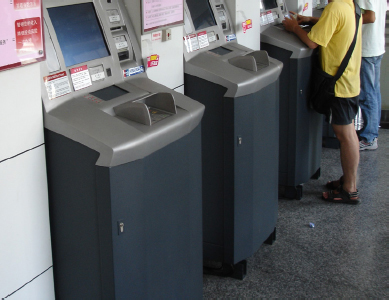
Figure 8-7. ATMs in a Beijing branch with transportation legs still fitted
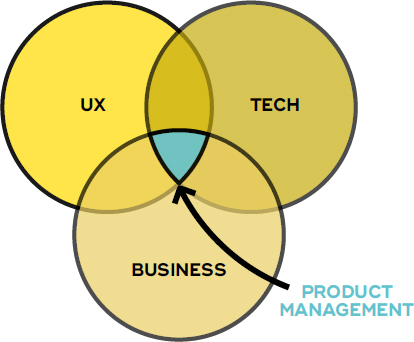
Figure 8-8. Product management Venn diagram: 18 product management sits at the intersection of UX, technology, and business.

Definition phase
Yet, before the actual realization phase starts (which often comes with a standardized process with a rather rigid project milestone concept and tight schedule), there is typically a definition phase, which can have the form of a pre-project. At this stage you need to verify the concepts, build further prototypes (e.g., for new interaction concepts, new technology, new materials etc.), test them, and alter them. Within this phase the product manager builds the foundation for future developments. According to Vijay Kumar, “The next challenge is to combine compatible and valuable concepts into reliable and systemic solutions that are actionable for future successful implementation.” 19
A product requirement document has to be created for further development. This document contains all the requirements a certain product has to fulfill and helps everyone in the later development better understand what the product is expected to do. Depending on your preferences, this can be a “real” document, a spreadsheet, or a dedicated software solution. Besides customer requirements, as a product manager you have to prepare a holistic picture of the future solutions and combine concepts. Thus, the product requirement document also includes the context – like industry standards (e.g., size of machines, maximum weight etc.), any relevant regulations (e.g., regarding security or usability), and also the business side. These requirements should also be accompanied by the prototypes and the learnings from early evaluation.
This definition phase (or pre-project) is the basis for your realization phase, where the actual development of a physical product and/or service takes place. The definition phase is often conducted with a smaller team, but when it comes to realization the number of people involved increases rapidly, as do costs. Consequently, no matter whether your company has a waterfall approach or a more agile one, at some point you need a schedule, budget, and staff.
The deliverable of the definition phase is typically a product requirement document, tested prototypes, and a project plan for the realization phase.

Realization phase
When it comes to the development of new products, speed is of great importance. “Because we pursue innovation in a competitive marketplace, speed matters. The faster that great ideas get to market, the faster we earn money, build our brand, and extend our reach into the future.” 20 In software development lean and agile development processes are widely followed already. 21

Yet, many companies still struggle to apply these concepts to the development of physical products. The reasons are manifold: sometimes it is just not possible to split the final solution into smaller pieces (think about some big machines in the recycling industry, for example) or test it without the whole system. Many companies have introduced standardized processes for recurrent tasks and consequently follow a classical, milestone-driven project management approach for the development of physical products.
A generic product development process during the phase of realization might look like the figure above, yet in practice it is never that linear and has iterations in it as well.
During realization the role of the product manager is crucial. One of the most important tasks is to constantly remind the development team of the user needs. Due to the growth of service design, more and more product managers are using personas in the early phases of product definition. One approach that has turned out quite well in practice is to have members of the development team adopt these personas during realization. Basically, each team member adopts one persona and has to take care of that persona’s needs during the entire development process. In this context not only personas for customers are used, but personas for all kinds of stakeholders. In the case of an ATM, there might be personas for a service technician, a bank employee, or a third-party software provider. Whenever a new concept is reviewed or a milestone approached, each team member can assume the role of her persona and give feedback in the persona’s name. This is a simple but effective method to apply a service design tool during the realization phase.

Support/use phase
When your product or solution is out in the market, you focus on market success and making profit. One model which can help you to decide which tasks are necessary for your product to stay successful is the classical marketing lifecycle model.
It distinguishes between different (sub)phases during the period when the product is offered to the market (the sales period). As a product manager it is crucial to monitor market success and to trigger the right actions during the market lifecycle in order to keep your product successful. In addition, you have to decide when a new product generation should be developed. Nevertheless, you have to keep in mind that in reality the lifecycle curve of your product might look very different from this idealized version and depends a lot on developments in the external environment (new competition, new regulations, overall economic situation, and more).
As outlined in the remainder of this section, your tasks as a product manager will vary during the lifecycle stages, and each stage offers chances to use different service design tools. 22
1 Market introduction
When introducing a new product you will need to get references, improve your sales channels, and probably eliminate teething troubles in your products. You can surmount these challenges if you have additional services ready, not only the product itself. Your sales channels should be properly trained and ready to provide you with customer feedback. You should be able to offer the right consulting and support to your customers so that they feel confident using your product as early adopters. An important tool to improve your offering at this stage is the customer journey map; monitor this closely so you can improve the customer experience by learning from your early customers. The example in the next section illustrates the importance of developing services related to the introduction of a new service and the importance of designing these services based on the needs of all stakeholders.
2 Market growth
Growth means that your product has gained traction. You now want to accelerate the growth rate. How could you grow your market share faster? How could you find new sales channels and optimize your offer for these new channels? How could you improve your customer relationships and your visibility? These are the questions you have to ask yourself. With new sales channels and new customers, you will feel the need to adapt and improve your product (new features, new variants). Think outside of the “product box” and consider services which could support these goals. Individualization becomes more and more important at this stage. After this, you will have to start again with the exploration of new customer groups and new applications for your products.
Example: An Austrian company developed a new innovative portable welding device, the first in its class. But after the market introduction they realized that people were reluctant to use the device and their customer base was growing slowly. So, the product manager decided that he had to offer more than just the product to customers and that another close look at the users was necessary. As part of a service design project, the company gathered new user insights and developed concepts for additional services. Now they offer a whole solution consisting of the welding device, an accompanying software service for better and easier adjustment of the device, and a ready-to-weld transportation package. With these additional services and offerings they have been able to significantly increase their market growth.

3 Market maturity
You have reached a good market share and you are making sufficient profit with your product. But it would be a mistake to think everything is fine and you can lean back. Now you will have to deal with competition in the market. You will have to defend your market share and find measures to differentiate your offer from the competition and keep your business as profitable as before. Now the time has come when you should start thinking about your next-generation product. To increase the lifespan of your product, it might make sense to relaunch the existing product or reposition your offer. By developing new, associated services and new revenue models you might be able to find new ways to differentiate your offer from the competition.
4 Market decline
The product is no longer attractive in the market. There are still customers buying it, but the profit is shrinking. Now your main goal is to avoid losses and hopefully prepare for the introduction of the next generation. To avoid losses you can reduce the internal and external support costs by eliminating product variants. You should also think about how you can keep or increase your service profits – for example, you could offer updates and retrofit solutions to the existing customers.
5 Support
The use/support phase does not finish with the sales decline. Customers are still using the products and they still expect some product support (repair, spare parts, retrofit solutions, and more). So, work together with the service department on revenue models for the support phase and find a way to capture user insights for the next generation of solutions.
Be aware that these stages might look different for your product. Nevertheless, service design offers product management a variety of tools and methods to make products even more successful during their lifecycle.

Retirement/disposal phase
The product has reached its “end of life” and the customer disposes of it. You should use this last touchpoint in the customer journey to introduce your new product generation and support the disposal process with useful services.
The role of services for product management
To sum up, the production, use, and circulation of products cannot be separated from associated services. Firms must not only focus on products or services, but should develop service–product combinations (solutions) to generate multiple revenue streams.
The transition from a product manufacturer to an organization that also offers services is challenging. It might implicate organizational and business model changes, new value propositions to customers, different pricing strategies, and innovative approaches to making services marketable.
Thus, today’s product managers have to discover new mindsets and methods, such as service design, to to generate tomorrow’s solutions by combining existing know-how and capabilities within the organization and along the whole supply chain.
Service Design and Architecture
AUTHOR
Minka Frackenpohl
This section sets out to connect two disciplines that originate from a similar background. However, the way they are performed is quite different. The aim here is to identify opportunities where architecture and service design can learn from each other and outline chances for them to merge.
When graduating from architecture school in 2009, I presented a basic architectural structure. It consisted of a foundation slab and a concrete core, containing a bathroom, a kitchen, and a staircase. As well as the structure, a process was described to complete the basic house. In this process, the future inhabitants could build their houses themselves and develop them individually based on their needs and at their own pace. After the hand-over of this basic house to the residents, the new owners would decide how to use the building services offered. Within this service, clear anchor points were designed for the users to add material and build up knowledge or expertise. Overall, this project aimed at building the capacity of an ethnic group. The service created various touchpoints for inhabitants to use when needed.
My auditors greeted me with incomprehension. Why should people design and build their own houses when there is an expert (i.e., the architect)? This experience illustrates the dilemma of architecture: the claim of an almost universal knowledge of the subject and about the future users. User needs are rarely identified prior to planning, nor are stakeholders part of the design and planning process. This means their needs and creative input are seldom included in the development of a building. Classic architecture is understood as a manifested singular, to be used in its current form rather than being part of a process, used as one piece of a service ecosystem. The usage of a building may, however, change over time. Future-ready buildings need to be developed employing holistic building processes.
In many countries, the architectural process is divided into clearly defined phases, structuring the classical architecture project. The Royal Institute of British Architects (RIBA) has defined seven work stages, which are described in the Plan of Work Framework. They reach from preparation (appraisal and design brief) to use and aftercare (post-practical completion). Within this framework, however, there is still a need for some additional aspects that may lay the groundwork for enriching the profession of architecture. The equivalent phases are obligatory within the service design process and rich with highly developed methods and tools: a change of mindset from a singular to being one part of a system, identification of user needs, co-creation, and prototyping.
In the following sections, six stages will be described. These describe joint phases of the architectural or service design process and are matched to both or one of them. They identify possible areas for enriching the architectural practice with approaches and tools from service design.
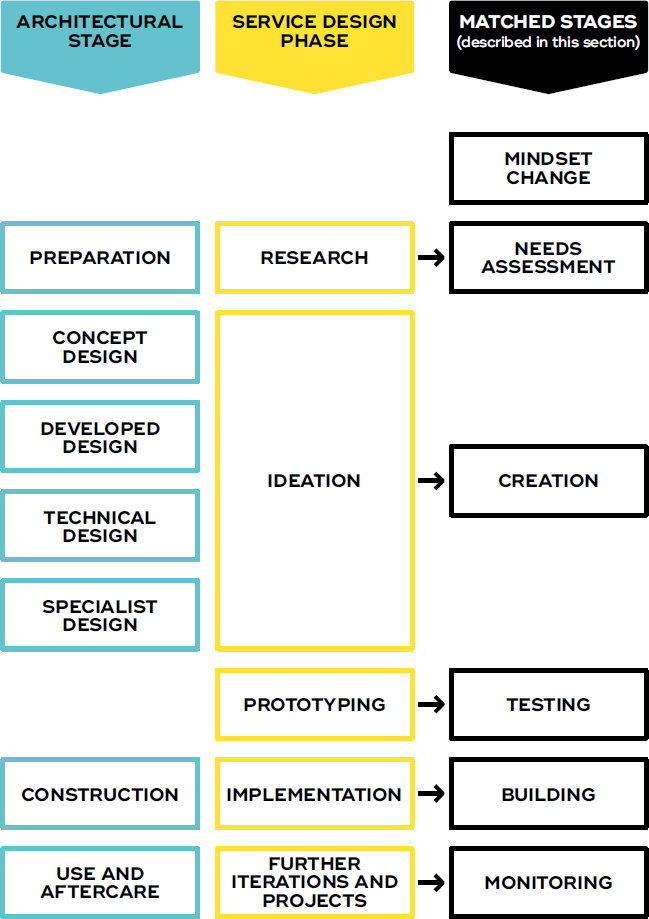
Figure 8-10. Comparison of architectural and service design stages that are matched to the stages described in this section.
Stage 1: Mindset change
The first stage sets the groundwork. Architecture has been viewed since modernity as a single static building or conglomerate of various forms. There is a great opportunity in perceiving architecture as a process rather than a static building. In service design, we look at the whole system as the product, whereas in architecture the one product is the building. In order to make architecture part of a service ecosystem, the built environment must be redefined as one touchpoint and the building itself as a physical manifestation.
Stakeholder maps can be used to make sure all the people involved in the lifecycle of a building (everyone involved in designing, building, using, monitoring) are represented. This helps to set the groundwork for integrating all (built) needs during the process. Creating an architectural customer journey of people using the building identifies touchpoints, whether service, product, or built.
We worked with the team from Cowoki, 25 a Cologne-based startup that provides coworking combined with childcare. During this project, we defined the journey for various users of their service and set the focus on what the built space needed to provide in order to match the needs of different user groups (e.g., community space, quiet areas, and telephone boxes).
Creating a customer journey of coworking with a child using three identified personas. The focus is on how the different spaces within the coworking space serve the needs of a coworker and a child. 26

User-centered spatial solutions at the Stanford Center for Innovations in Learning. 27
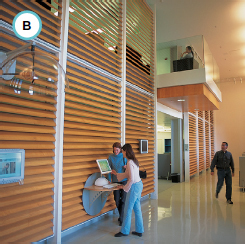

Stakeholders creating the Dream Space Map “Living and Residing as Seniors in Rural Areas.” 28
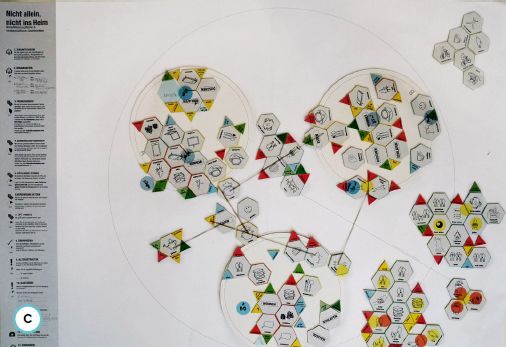
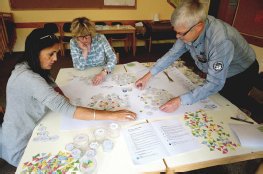
Stage 2: Needs assessment
As architects, we should aim to deliver the best solution for the buildings’ users. For this reason, it is fundamental to understand their specific needs. In the 1960s, the concept of programming, or briefing, evolved in America. 29 Programming is called Phase 0 in the architectural process and different tools are used during this phase to gain knowledge about the later users of a building. It is a research and problem-solving process, used to identify, examine, and elaborate various needs within a design project. Methods used are brainstorming, contextual interviews, benchmarking, building inspections, and relationship graphs. Programming is now part of the first phase within the American Institute of Architects’ service catalogue. However, in other countries, such as Germany, it is not yet part of the official framework. This makes it difficult for a potential client to understand why to commission this extra step, and it is seldom assigned. In addition, if assigned, there are no recommendations for action or a structured approach to take the client along.
As an example from the design perspective, IDEO worked together with the architect and staff members at the Stanford Center for Innovations in Learning. This project showed how the architectural process and the assessment of user needs can be united. The team did six weeks of research, including on-campus interviews, photo surveys, and shadowing, to understand the work process of the students and the Center’s staff and faculty. “This work informed the design documentation IDEO delivered, including visualizations of every aspect from architecture and furnishings to information systems and protocols of use.” 30
Stage 3: Creation
When talking about new or creative methods in architecture, user engagement within the pre-design phase is often mentioned (as described earlier). But what about integrating the stakeholders into the design phase and handing over the pen?
Considerable efforts have been made to integrate stakeholders into the process of urban planning, reaching back to the 1940s, when the British government used reconstruction after World War II as an opportunity to engage the public. Planners created new techniques to communicate with laypeople such as mobilizing publicity, measuring public opinion, organizing exhibitions, and experimenting with new visual strategies. 31 For co-creation, various tools are conceivable (e.g., idea generation, design scenarios, or storyboards).
In the book Architecture Is Participation (Partizipation macht Architektur), the Berlin-based architecture company Baupiloten introduced their methods for participatory design. 32 “Negotiate the dream space” is one method they work with. This board game uses activity and atmosphere cards to co-design space. In their project “Living and Residing as Seniors in Rural Areas,” stakeholders “negotiated a future life in the country. Initially each player developed a vision for their personal area and then they negotiated the communal facilities for all of them, there was both a great need for privacy as well as a willingness for neighborly interaction – such as through the connection of two units by a common area for communal cooking and eating.” By creating a Dream Space Map, needs for spatial relationships and atmospheric qualities are revealed.
Stage 4: Testing
Building architectural models is essential to every building project. Working models are built to study aspects of an architectural design or to communicate design ideas. Thus, an architectural model might be something used as a first quick prototype. Models are, however, rarely used in this way in daily architectural practice. Mostly they are built during the very last design phase and act as a visualization and sales tool for the finished design. Looking at it from a design thinking perspective, the possibilities of a prototype are manifold. By introducing early-stage modeling, the design inevitably benefits. Working models help the architects to understand their own designs better while supporting communication with the stakeholders and hence strengthening the process and the trust between the parties. Tools used may include architectural staging, LEGO® SERIOUS PLAY®, or building prototypes.
Baupiloten uses an exploration game they call “Test scenarios.” The game uses spatial modules in a specific architectural scale. “The aim is to enable users to adjust their needs and desires within the future built environment, using these building blocks, which transfer easily into the design process because of their scale.” 33
As another “doing” example, we undertook a semester project in cooperation with Deutsche Telekom. The students were to create ideas on smart housing, and prototyping was one part of the process. By creating prototypes, the students produced very deep, detailed ideas, and the concepts were truly enriched compared to the previous outcomes.
Stage 5: Building
After the building is planned, the architect functions as the touchpoint for contracting the craftspeople. Offers are collected, tested, and evaluated. Bidders are negotiated with and orders are placed. Additionally, the architect takes on the cost control of the building process. Once all tradespeople have been hired, the architect coordinates and supervises the implementation. One could say that building is a rather technical phase. So where are opportunities for service design in this stage?
A helpful tool that is often used is a “catalogue of intersections.” This catalogue details the planning process and the intersections between all involved parties. 34 Though it is not part of the officially mandated working documents, this helps keep an overview during the long building phase. Combining the catalogue of intersections with a stakeholder map can have great effects on the smooth working of the building process.
The craftsmen form an important interest group at this point of the architectural process. They are dependent on the architect’s planning, as well as obliged to fulfill standards within their fields of expertise. Speaking to them and enquiring what they need to render the best service they can should be in the architect’s interest as well. However, the official requirements regulate contact between architect and craftsmen solely in terms of technical implementation. A structured assessment of the craftsmen’s needs and a clear definition of the intersections between the trades can improve the process. For example, if there is a technical innovation within one craft, this novelty might have an impact on the design of the building and the architect might benefit from receiving early information on it.
Relationship model of a community organizer; semester project on smart homes. 35

Children building up a model for their own play area in “Le Buffet kids restaurant” based on their needs and imagination. 36
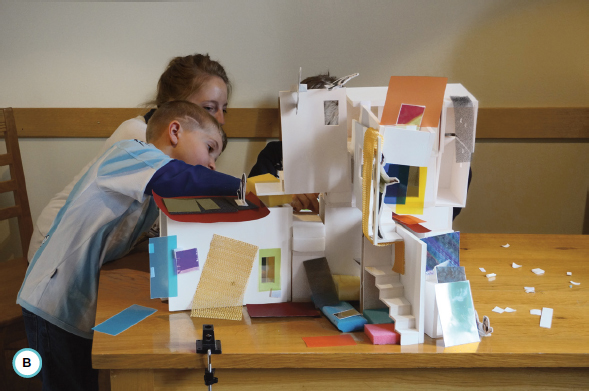
The later users of the building don’t play a role within the building phase. If you look at it from a technical point of view this seems quite logical. On the other hand, this stage marks the first visible touchpoint of the later building. At this point, users are eager to get engaged and receive information. This is a good time to reinvolve those parties, either by showing them the actual project status, confirming their needs (to abe able to adopt possible changes in the detailed planning as soon as possible), or even conducting a late co-creation workshop targeting aspects which can still be changed (e.g., detailed planning, interior design).
Stage 6: Monitoring
The last phase of the architectural process, monitoring, defines the use and aftercare activities after the building is finished. For example, for office buildings it is common to hand over an operations and maintenance manual to the owner. This is a technical report which contains things like care instructions for the floors or operating instructions for the ventilation system as well as the built drawing. It generally does not include the human factors of using the building (e.g., why certain decisions were made and how rooms can be used flexibly). There is a lack of transfer from the findings of the needs assessment stage to the implemented use of the building. Within the German HOAI (the schedule of services and fees for architects and engineers), two obligatory services are described: assistance in the release of guarantees and the compilation of graphic and textual documentation. As an additional special service, the architect may offer site inspections for user groups after handover. However, this is the sole (perhaps contracted) post-build opportunity for the architect to re-engage with users. After this, once the building is in use, any earlier efforts in integrating stakeholders and especially users by assessing their needs are not reflected.
Changes and the in-use evaluation of residential and office buildings, for example, are not part of the classical architectural contract. Once a building is finished, the decisions made in planning are set in concrete. In a finished building one can’t easily remove walls or change the structure as one can within a classical service. Thus, how would a post-occupancy evaluation be of value? There are at least two reasons to expand the classical architectural process here. First, catching up with users helps manage the expectations set earlier and opens an exchange for ongoing improvements to the building. Involving users could be done through feedback workshops using methods such as walkthroughs or “a day in the life”. In addition, it is a great opportunity for the architect to learn for the next project.
On the other side: What can service design learn from architecture?
Although this section focuses on improving the architectural process by integrating service design skills, there are options for service design to learn from the field of architecture.
The title “architect” is protected, and it may only be used after intensive university study and evidence of practical experience. This ensures a consistent quality of delivered services. Due to the presence of architectural associations, architects have a united voice that allows them to address their needs in order to work professionally. The performance of the architect is structured within the work phases and the fees for the respective work phases are set in fee scales (e.g., HOAI in Germany). As these structures do not exist in the field of (service) design, there is a chance to establish an equal standard of quality in work and results.
We have seen that there are various fields of opportunities for service design doing in architecture. If designers are able to dismantle the fixed structures within the architectural process, there are many possibilities to enable innovative space solutions that represent great physical touchpoints within service ecosystems.
Excerpt of the catalogue of intersections. 37

Cases
The following four case studies provide examples of how service design implementation can take place in practice: how to empower employees for sustainable implementation of a service design project (“Case: Empowering Employees for Sustainable Implementation of a Service Design Project”), how to implement design doing to transform customer and seller experiences (“Case: Implementing Service Design to Create Experiences, Momentum, and Results In sales”), how to implement service design in a software startup (“Case: Implementing Service Design in a Software Startup”), and how to create measurable business impact through piloting and implementing a service design project (“Case: Creating Measurable Business Impact Through Piloting and Implementing Service Design Projects”).
8.6.1 Case: Empowering employees for sustainable implementation of a service design project
- Best ride there is! How to create and maintain a perfect customer experience
- — Mario Sepp, Founder, Gastspiel
8.6.2 Case: Implementing service design to create experiences, momentum, and results in sales
- Transforming customer and seller experience
- — Jurgen De Becker, Vice President, Global Solutions Consulting, Genesys
- — Lisa Gately, Senior Director, Content Strategy, Genesys
8.6.3 Case: Implementing service design in a software startup
- From canvas to reality
- — Klaus Schwarzenberger, CTO, More than Metrics
- — Jakob Schneider, CCO, More than Metrics — Marc Stickdorn, CEO, More than Metrics
-
- Creating a vision for the future: Sustainable, high-quality care for the elderly
- — Ingvild Støvring, Service Designer, Livework
- — Rune Yndestad Møller, Senior Business Designer, Livework
- — Melissa Gates, Communication Designer, Livework
- — Marianne Rolfsen, Senior Service Designer, Livework
Case: Empowering Employees for Sustainable Implementation of a Service Design Project
Best ride there is! How to create and maintain a perfect customer experience
AUTHOR
Mario Sepp Founder, Gastspiel

Edelweiss Bike Travel set out to orchestrate an even better experience for their customers. With the help of Gastspiel, Austria, they analyzed and improved their end-to-end customer journey. The most important factor was employee training.
Initial situation: A healthy company with tradition
Edelweiss Bike Travel – the world’s leading company in guided motorcycle tours – has been providing motorcycle and scooter touring around the globe since 1980. Around 50,000 customers – mainly from the United States, Brazil, Canada, and Germany – have been on an Edelweiss tour. Featuring the latest motorcycles, 12 different tour categories, from basic tours to luxurious vacations, are offered in 75 locations.
Design challenge and project goals
Edelweiss Bike Travel certainly provide great customer service, but it is “legendary” service that they strive for. Only when their clients’ expectations are exceeded is a tour considered a success.
The service design challenge: after 35 years of doing motorcycle tours around the globe, Edelweiss Bike Travel decided to revamp and standardize the customer experience on all of their tours. The company was continuing to expand and the growing number of tour guides from all over the world – who are all freelancers – posed a real challenge to staging a continuously consistent customer experience for the equally growing number of new and loyal clients.
In particular, feedback from regular clients – who often booked the same tour a second or even a third time and sometimes brought along acquaintances and friends to whom they had previously warmly recommended Edelweiss Tours – clearly demonstrated what enormous influence each individual tour guide ultimately has on the perceived quality of the customer experience.
But there was yet another factor that was rapidly gaining increasing importance. Since Edelweiss Bike Travel is the official partner for BMW, Ducati, Triumph, and Harley, it’s important to recognize that these companies insist on a perfectly orchestrated customer experience for the clients when their motorcycles are used on the tours.
“We just don’t run tours, we want to deliver the ultimate customer experience – and that is before the tour, during the tour, and of course after the tour!”
— Rainer Buck, Managing Director, Edelweiss Bike Travel
The agency’s approach: A classic service design process
Gastspiel was selected to develop and co-create – together with a prestigious team from Edelweiss – the new “Edelweiss Customer Experience.” After in-depth design research (which was carried out in the form of observations and ethnographic methods as part of the preparation, implementation, and follow-up of different motorcycle tours), devising and drafting a stakeholder map, the mapping of the customer journey and development of associated personas, and the design and implementation of the new customer experience finally took place.
Besides various improvements to the customer journey before and after the tour, the spotlight was clearly on the tour itself. Management recognized that the tour guides and their behavior are the absolute “make-or-break factor” for the individual guest experience. To launch and embed the new “Edelweiss Customer Experience” in a sustainable way, a new Tour Guide Training program has been implemented.
How implementation worked in detail
The service design process has evolved tremendously over the last few years, but the biggest challenge has always been the sustainable implementation of the designed customer experience measures throughout the whole organization.
Employees with direct customer contact in particular have to be in the position to stage the designed customer experience in their daily routine, regardless of their length of affiliation with the company: “We are what we repeatedly do.” To overcome this challenge, we have created a new method of video-based service training, where employees are not only taught to stage the perfectly designed customer experience step by step, but can also instantly experience the impact of these steps on the customer.
The service training video, which is divided into individual training segments, shows all the previously mapped out processes and procedures in real-life situations between company and client along the entire customer journey. Within the scope of the Tour Leader Training, a common reflection on the just – viewed situation was carried out after each video chapter and the most important details were recording. An appropriate “Quick Reference Guide” was developed, containing all the relevant information in compact print; this is carried by each tour leader for safety reasons, ease of reference, and in general in aid of carrying out all the appropriate tasks during a tour.
Talking to the employees
It is of utmost importance to stress the emotional aspect of the customer experience and make employees directly and equally experience what enormous importance each customer experience means to the company, and what incredible responsibility each employee carries and must therefore fulfill.
Anything that touches people on an emotional level will remain far more strongly rooted in their memories than mere situational experiences and procedures which are only taught or conveyed by means of printed matter. It is therefore necessary to take course contents to an emotionally tangible level.
Comprehensive customer journey maps laid the foundation for the whole process. Used as a tool for convincing employees and developing new customer flows, it has been crucial throughout the project.
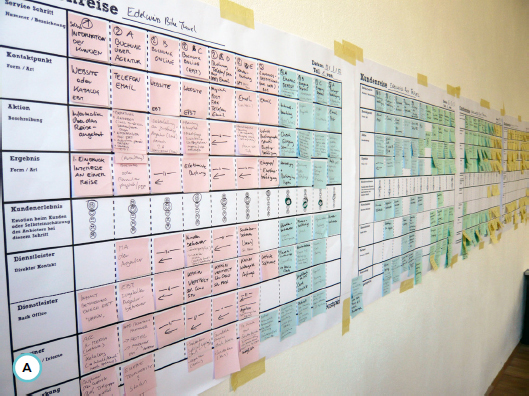
Team members setting up checkpoints according to the newly developed guidelines.

The back office team taking care of backstage processes, on the basis of a storyboard hanging in the background.
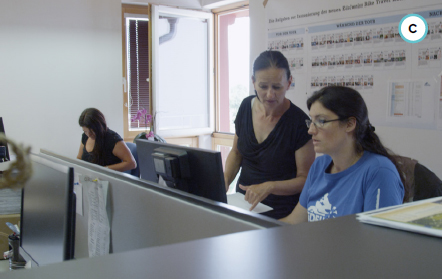
The new employee guidelines: the foundation for all face-to-face interactions.
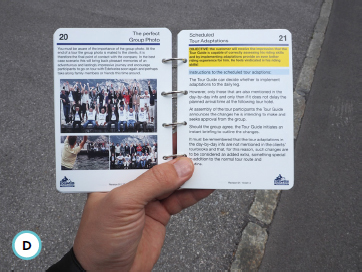
A personal welcome: creating physical evidence for intangible services.
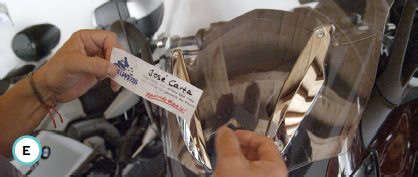
Team coaching taken seriously.
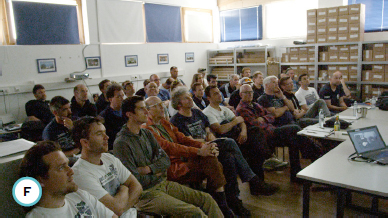
The better each employee understands and grasps this reality and the better each employee comprehends the fundamental advantage for himself, the better and the more willingly he will focus his effort toward meeting and satisfying customer expectations in the interest of the business. From Service Design to exceptional Service Delivery!
Customers will not always remember in detail what they have been told or what has been done for them, but they will always clearly remember whether you made them feel good.
Measurable results after employee training
The feedback Edelweiss received from their customers from the first tours thereafter was overwhelming – and it was proved once again: great customer experiences create great business results. After completion of the project, Edelweiss Bike Travel was able to celebrate the most successful business year since its inception in 1980!
Key insights and learnings
Compared to static pictures, mere text, or spoken information, the video medium provides a far greater density of information, especially when individual modules are used. The tailor-made service training video – which was made authentic by filming actual clients and employees in real-life, everyday situations – not only depicts the training content in a visual and vivid manner but also conveys it on an emotional level, which in turn positively enhances the acquisition of knowledge and results in a significantly improved and sustainable anchoring of the learned content.
To communicate the required ways of conduct, necessary explanations, and specific actions and behaviors desired by the tour operators a sophisticated didactic concept was developed which was ultimately implemented in accurately adapted audiovisual material and finally compacted in the training video. The employees are consistently shown the correct procedures and each individual employee is guided by them in practice, obviously within their personal scope.
“What I get out of this – more than anything – after all the tours I’ve done, is the people. Not only the riders, but the tour guides. I just love this. So the combination ...it’s the people more than anything. And I want to thank everybody for making my life more whole.”
— Customer, Edelweiss Bike Travel
That way the company facilitates, for both new and longtime employees, a better understanding of which services are relevant at any given time and in any given manner for a perfect customer experience and further assists them by showing them how they can successfully implement these services in their immediate everyday work.
Because nothing must be left to chance, it is important nevertheless that any course of action must be perceived as authentic. Quite a challenge indeed! Especially in the field of soft skills, relevant video segments depicting interpersonal situations can be experienced in an emotional and authentic way as opposed to viewing mere text or graphic illustrations.
In particular, the fact that the team of tour guides comprises people of different nationalities makes it all the more important to ensure that each one of them equally understands the relevant training content. In fact, we were able to see the effects of the new service training video even before the first tour leader training sessions were carried out.
Gaining internal pride for the results
The presentation of the completed video to the owners, management, and the members of the project team met with equally incredible emotional reactions in all – they were truly moved, touched, and most of all incredibly proud! Proud of “their” company, proud of their personal performance and that of the entire team, and proud of their commitment and the honest effort of their employees in their daily interaction with clients.
Team emotions as driving factor
One thing is clear – such strong emotions are a huge motivational factor and strengthen loyalty to the company. It was therefore all the more gratifying that we received this “I’m really proud to be part of the Edelweiss Bike Travel Team!” as unanimous feedback from all employees at the end of the training sessions we conducted. This spirit of togetherness and the employees’ convinced attitude and feeling of loyalty toward their company and its services are obviously also felt by the customers of Edelweiss Bike Travel. And it is exactly that which is without doubt the best and most sustainable basis for authentic and therefore unique customer experiences!
Key Takeaways
01 Visualization tools like customer journey maps are crucial for basic understanding of a common goal across the team.
02 Outstanding services rely on empowered employees.
03 For employees, not only training but also deep understanding of the idea of customer experience is important.
04 Dedicated training material, such as video and printed guidelines, can help with sustainable implementation of new concepts.
Case: Implementing Service Design to Create Experiences, Momentum, and Results In sales
Transforming customer and seller experience
AUTHORS
Jurgen De Becker Vice President, Global Solutions Consulting, Genesys
Lisa Gately Senior Director, Content Strategy, Genesys

Today’s digital revolution has fueled enormous customer engagement expectations. Nowhere is that more clear than in the contact center, where customer engagement models have rapidly transformed. Genesys, a popular global customer experience platform, knows this very well from 25 years of empowering companies to create exceptional omnichannel experiences, journeys, and relationships. With over 4,700 customers in 120 countries, Genesys orchestrates over 24 billion contact center interactions per year in the cloud and on-premises.
However, with its fast growth (acquiring 12 companies in 4 years), and entry into new market segments while expanding its portfolio, Genesys needed to transform its model for working with customers. A small core team was formed, with leaders from marketing, sales, and services, to solve what became a service design challenge. Genesys needed to accelerate customers’ time to value and improve their buying journey by bridging the company’s technology and expertise across all customer-facing teams. In particular, sales and services teams needed to drive repeatability and standardization with a common methodology and toolset, while also helping customers visualize and improve the customer experiences they deliver.
The challenge of increased complexity
For many companies, success is now about delivering connected customer experiences across multiple journeys and channels, including phone, interactive voice response (IVR) systems, email, social media, web chat, text, mobile applications, video, and other IoT automated services. At the same time, customers perceive value based on business outcomes, not necessarily the price of an offering, and they make comparisons to the best experiences they’ve had in any industry.
Anticipating these market shifts, Genesys’s portfolio grew rapidly and its sales model began to evolve from a product-based to a solutions-based, consultative approach. But these changes introduced more complexity and inward, rather than outside-in, thinking. This complexity started affecting customers’ experiences in their buying journeys, and the collaboration between Genesys teams.
A cross-functional team of sales, marketing, and services leaders created a mission to optimize both customer and Genesys outcomes with a consistent approach: creating and delivering memorable “wow” customer experiences. The SMART Method project was born, and it became a corporate transformation program, sponsored by the CMO and global sales and services leaders to break through departmental silos.
Creating memorable “wow” experiences
The first steps in change are often the most difficult ones, and this was true for the SMART Method. Stepping into the customer’s shoes and moving beyond the limitations of current internal tools and processes for sales and services teams required a completely new mindset.
A key event in bringing the core team together was completion of the “This is Service Design Doing” course. The shared experience brought customer centricity to the forefront of all discussions, and shaped our use of common tools and language. Thereafter, conference rooms were decorated with journey maps, stakeholder maps, and service blueprints. The technique of “octopus clustering” even became part of a sales training exercise.
The “Double Diamond” (Design Council, UK) was an inspiration for the SMART Method’s core design process, which starts with extensive research. The team confirmed the most important experience gap in the buying journey: the touchpoint when the customer requirements are being identified. While customers appreciated the Genesys CX vision, they perceived it as complex and often missed insights about how to achieve business outcomes. Therefore, the first design challenge focused on providing quantifiable value and a clear path to the target state. This became the basis for multiple iterations and prototypes.
The resulting service design–led approach specified that the sales team and the customer analyze the end customers’ journeys together. Products become a means to an end, which is to help companies deliver great customer and employee experiences, with efficient operations. The historical focus on product features faded to the background, while building relationships, reimagined journeys, and great business outcomes gained the spotlight.
Implementing small steps to build momentum and results
Within six months of its inception, the SMART Method was introduced to the entire Genesys sales team during the annual sales conference. With the support of service design thinking (and doing) experts, we provided context and insights into the design process. The feedback was very encouraging, with 88% of the sales team agreeing that this method would reduce the customer’s time to value and create new experiences.
After this introduction phase, the cross-functional team worked to guide expectations during the implementation with the Genesys teams. One of the first challenges we encountered was overcoming the sales team’s hesitance of entering design doing conversations with customers, or the question “Am I creative enough?” We discovered that a design doing approach led to even better customer conversations, with customers sharing meaningful details and stories. Early experience also revealed that sometimes being simple and pragmatic is all you need. Finally, we learned how important it is to find the right journey when working with customers.
A customer lifecycle includes many journeys, and design thinking allows us to imagine many future possibilities. However, we needed to identify the most relevant journey in a customer’s situation to start design doing, and not lose momentum. Working together in an agile manner, taking many small steps and learning across the sales team with some pilot customer projects, led to great initial results.
Design doing in action: The Genesys team discusses customer touchpoints and potential approaches to a design challenge.

The SMART Method (initially called the WOW Method) was inspired by the UK Design Council’s Double Diamond. 38
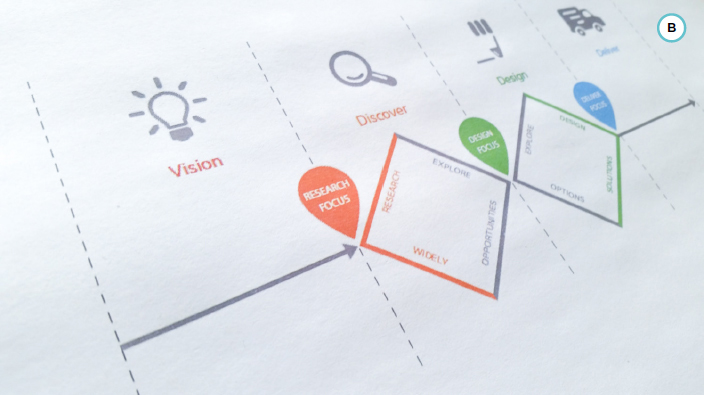
Jurgen De Becker of Genesys presents early results and direction during the company sales conference.
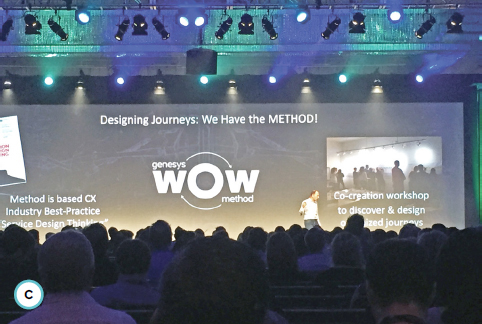
As the program grew, an important next milestone was to establish a small, dedicated team to facilitate design thinking in the customer lifecycle and implement new tools for sales teams. This team not only focuses on optimizing experience, but also on building and sharing knowledge across the sales and services teams. Each co-creation process conducted with customers generates valuable insights where new service capabilities can be added to the solution portfolio. Establishing a center of excellence was a critical step in implementing the program and making design thinking a core discipline.
Although the SMART Method is still in its infancy, we are achieving positive results. Service design has helped Genesys transform to creating more intuitive, personalized customer (and sales) experiences. What started as a small stealth-mode initiative has quickly gained momentum in helping the company reduce complexity, break down silos, and bring a thoughtful, human approach to our business.
“Service design has transformed how Genesys teams engage with our customers. We have changed the conversation with journey mapping becoming the vehicle to discover and co-create new, innovative customer experiences together. This approach has proven to be very effective, and clearly helps our customers transform how they create great customer experiences with their customers.”
— Mark Turner, Executive Vice President of Global Sales and Field Operations
Key Takeaways
01 As a company grows, you can’t let the focus shift away from the customer to internal changes. Never lose sight of the customer experience!
02 Stepping into the customer’s shoes requires a completely new mindset and, to act on this, a common culture across teams.
03 The point where you identify customer needs can be the biggest experience gap in the customer journey.
04 Design thinking and doing can bring simplicity to your approach.
Case: Implementing Service Design in a Software Startup
From canvas to reality
AUTHORS
Klaus Schwarzenberger CTO, More than Metrics
Jakob Schneider CCO, More than Metrics
Marc Stickdorn CEO, More than Metrics
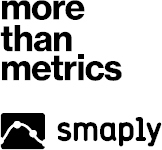
Starting a business with service design in its DNA
When we published our book This Is Service Design Thinking, we promised an app to work with the Customer Journey Canvas. However, we quickly discovered through contextual interviews and workshops that our initial idea was not enough. We understood that users need more than just a digital version of our paper canvas. They need a tool to quickly create entire journey maps that they can share and use in workshops – an insight that guided us throughout the whole development process. Based on feedback we received from our consulting clients and the wider service design community, we realized that we need to build web-based software that allows users to create professional journey maps (e.g., after a workshop to share with all participants and as an input for further iterations). What started as a simple side project to our service design consulting developed into a startup. We even had a business plan …
Smaply became a web-based tool to visualize personas, stakeholder maps, and journey maps. This case focuses on our prototyping process and how we prototyped, tested, and changed our business model over the years.
Starting bootstrapped
Boosted by the sales of our book and the resulting interaction with service designers from across the globe, we felt the timing was right. In 2011 journey mapping started to become mainstream. In 2012, our founding team combined the most needed skills for a software startup: technology (Klaus), design (Jakob), and management (Marc). We were able to handle most tasks ourselves and had very close access to our potential users and customers. This made initial researching, prototyping, and testing very quick and cheap. The actual concept and business model were still subject to permanent change.
We started with many assumptions based on our own service design consulting experience, but still needed to validate these through research.
As we needed to stay flexible, we combined our agile development process with a team-wide iterative service design process. So, not only was the software itself developed in repeating loops, but we also developed our underlying business model iteratively.
As the service design community was quite interested in our project, we originally planned to finance the development of Smaply through crowdfunding. Unfortunately, international crowdfunding platforms didn’t support projects based in Austria in 2012. We had the naive notion to set up a crowdfunding platform ourselves. Unfortunately, we were fighting legal boundaries in Austria at that time and had to discard this approach for legal reasons. 39 To finally get started, we decided to bootstrap Smaply and finance everything out of our own pockets.
Developing our business model
We planned Smaply as a classic Software-as-a-Service (SaaS) product. The interesting aspect about these business models is their scalability: you maintain relatively stable costs, no matter how many products you sell.
One crucial aspect of SaaS business models is their pricing. In the beginning, our pricing was based on gut feeling. We are experienced SaaS users ourselves and asked ourselves what we would pay for this kind of software. So, we created a “Starter” and a “Regular” plan for €10 and €25 per month, respectively. The idea was simple: if we convinced 200 customers to buy the Regular plan, we’d be able to cover our basic costs. We had no employees at that time and planned to develop a first version of the software ourselves. 40
Selling alpha and beta access
Of course, we didn’t just rely on our gut feeling when it came to market potential and product/market fit. Through early iterations and research phases during our closed alpha with selected users from the service design community, we already knew that the tool served a need for companies and agencies doing service design. 41 One research question we had though, was “Is this need big enough that users would actually pay for it?” To answer this question we took a more radical step and did some research through value prototyping.
We set up a prototype to test the market response and price sensitivity. We offered 100 “alpha accounts” for €30 each. This basically meant: “Hey, you can check out our sh!tty first draft, but you have to pay for it! We were surprised when these accounts sold out in 24 hours, and decided to offer another 100 beta accounts for €50 each a few weeks later, experiencing similar success. Selling alpha and beta accounts helped us to identify and connect with our most engaged users.
Draft for Smaply crowdfunding website that never went live.

Sh!tty first draft of a Business Model Canvas for Smaply as planned in 2012.
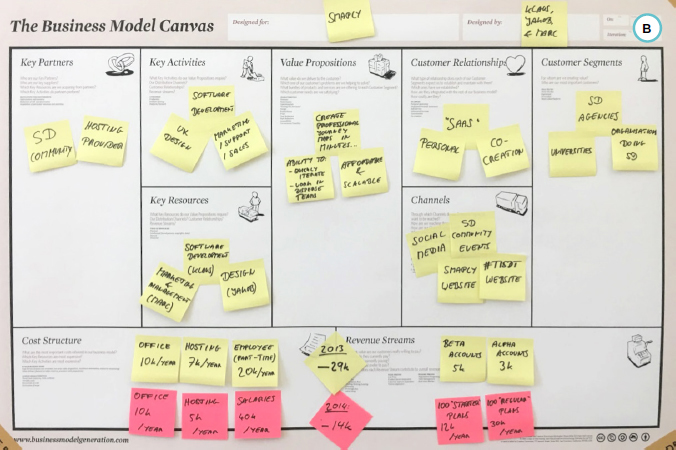
Prototyping market response and price sensitivity by selling alpha and beta accounts in 2013.
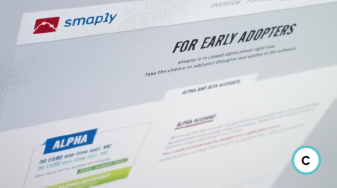
Original feedback we received from Markus in 2013.
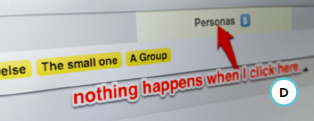
The 2017 Smaply with increased flexibility.

Our idea wall: a physical board to collect ideas from our team and users that we use as input for our internal workshops.

A poster in our office to remind the team of our server overload.
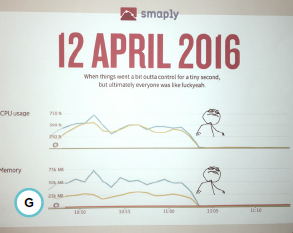
Building a community
In 2013, we had about 50 invited closed alpha users, 100 paid alpha users, and 100 paid beta users. On that basis, we tried to establish a long-term relationship with the most engaged users. That basically meant we talked to everyone. Some users were thrilled when we sent them long and honest answers to their bug reports and feature requests, or when one of their ideas actually made it into the final product.
One core aspect of building a community was thinking beyond the mere software. We started to offer free downloads of persona, stakeholder map, and journey map templates for paper-based workshops, but also sold ready-made paper templates through our online shop “Mr.Thinkr.” We rewarded our most engaged users with some free templates as physical evidences of the software.
Iterating product and pricing
We launched the public version of Smaply in December 2013. Within a few days we had the first few customers on board – most of them were alpha and beta users who converted their accounts. As we couldn’t handle everything ourselves anymore, we hired our first two employees in 2013. With increasing costs, we had to work on our business model and pricing. However, we wanted to make sure that our customers would have the feeling that Smaply was “worth it,” so we asked a few of them for their opinions. Backed with their feedback, we increased the pricing in 2014 to €25 for the Starter plan (limited to three projects and just one user) and €50 for the Regular account (unlimited projects and optional additional users).
Our initial concept was based on the idea of providing users with maximum guidance. This approach also includes limitations for users, like: “You cannot do this because it doesn’t make sense.” As our users got more and more skilled, we increasingly received complaints about this model. Users wanted to build maps in a more flexible way. We kept telling them how to work around problems, collecting more and more use cases. After two years of very iterative software development our code base looked like a patchwork rug. So, we decided on a complete rewrite of the software. Even though this was a major investment, this would increase stability and enabled us to finally tackle the flexibility issue of Smaply. We tested many new ideas with our most engaged users – often just roughly scribbled interface ideas on paper. Internal insight workshops brought together the learnings from our entire team through a healthy mix of analyzing research data, creating insights, generating ideas, paper prototyping, and creating digital mock-ups for further usability tests.
Connecting features with pricing in plans
Through intense dialogue with our users, we were able to learn about features and functions that appeared truly desirable. We were pretty surprised when users stated that a predefined storyboard image set (a rather simple thing for us) was much more important than real-time collaboration (a really complex thing to build).
Our most crucial instrument to understand needs and design features and pricing at the time (as well as today, after some growth) was a rather simple one: everyone in the team has meaningful conversations with our users. We don’t have a dedicated support team.
Everyone talks with users: the founders, the developers, the marketers, etc.
In our company, we all deal with support, usability tests, software demos, bug reports, complaints, and the like, following our own slogan: “Talk to your f***ing customer!”. This means everyone knows what the most prominent user needs are, and we discuss these every two weeks. We collect ideas for improvements, new features, plans, and pricing on our idea wall and regularly prioritize these with an idea portfolio based on impact on the users and impact on our business. This is how we co-create our backlog for future software development.
Growth
In March 2016, we stopped insisting on credit card details when new users signed up for Smaply. We underestimated how much this change would affect the signup rate: our new signups per month increased instantly by 1200% - and just two weeks later our servers crashed. A poster in our office reminds us of this day, but we were able to learn from our mistake and set up a new server infrastructure for faster growth.
Lessons learned
Our whole development process is now based on the iterative activities of exploration (talk and work with users), ideation/prototyping (build simple prototypes and test them as soon as possible, and implementation (get it out and directly start testing again). This is part of our company culture and we strongly believe that our success so far is deeply rooted in this approach.
Key Takeaways
01 Establish authentic relationships with your users and involve them in your innovation process. Reward them for their ideas and feedback.
02 Create a feeling of ownership among your customers and maintain a close dialogue with your most engaged critics – even if they have bad manners.
03 Implement the idea of an iterative process across your entire team. Make it clear that there is no “final” version of your product. Be prepared for the fact that people don’t like that feeling.
04 Accept that you don’t know that much about real use cases of your product. Don’t rely only on numbers. Ask humans.
05 Stick to your principles. It is essential to talk to people and co-create with them – but you are responsible for the big picture, and for the nifty details.
Case: Creating Measurable Business Impact Through Piloting and Implementing Service Design Projects
Creating a vision for the future: Sustainable, high-quality care for the elderly
AUTHORS
Ingvild Støvring Service Designer, Livework
Rune Yndestad Møller Senior Business Designer, Livework
Melissa Gates Communication Designer, Livework
Marianne Rolfsen Senior Service Designer, Livework

Oslo is facing one of the major global challenges – a rapidly growing aging population who will need some provision of care. The city service providers needed to find ways of managing demand while ensuring that quality is not only maintained but, if possible, improved. They asked Livework to help them define a vision for elderly care in 2025 that would be achievable, sustainable, and inspiring.
The agency approach: The first phase is always “understand”
To complement the council’s extensive data, Livework set about gaining insights via qualitative research. We conducted over 40 in-depth interviews with end users, their caregivers, admin staff, and care workers. We also made use of more covert techniques, including shadowing city staff engaged in home visits.
Desk research was also essential to widen our perspective and gain inspiration for different approaches from other sources. We conducted trend analyses in health and elderly care and researched best practices, looking at provisions in other countries. We also conducted an analysis of the economic impact of key needs and triggers, ensuring that service design walked hand in hand with the business perspective.
Developing and testing new approaches
After mapping existing customer journeys and running workshops with various stakeholders to gather further insights and generate ideas, we developed several tools which were integral to the project. The planning tools were used by all the various providers of elderly care, when they were planning their treatments. These enabled them to work across silos, using the same user needs–based tool irrespective of whether they were from the mental health department or the hospital, focused on nutrition or physiotherapy. The tools were designed not just to plan and deliver treatment in the immediate term but to plan and achieve longer-term goals, discussed and defined with the users.
We mapped users’ needs on a matrix which clarified areas where needs could be better met, and created further potential customer journeys. A set of nine service principles was developed to inform and guide the future delivery of services.
Piloting was done in parallel with business as usual, testing new service propositions backstage and frontstage, gathering insights from the staff that deliver elderly care and their end users. A key desirable outcome was ensuring that people remain able to live independently for as long as possible, and this was achieved by designing systems that enable the council to target their services to meet individuals’ needs more accurately and efficiently gain the best outcome for both the municipality and the users.
One pilot program alone produced savings that covered the entire cost of the project.
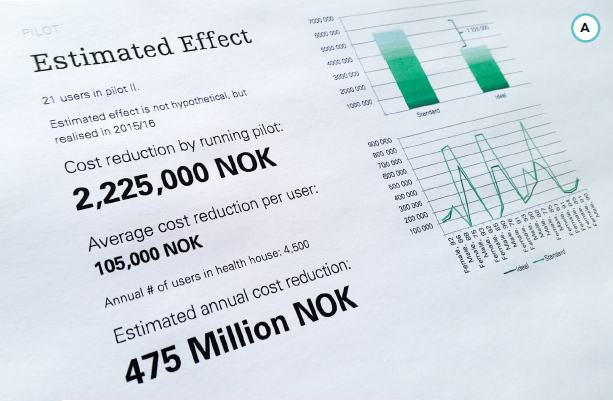
Livework mapped out the customer journeys of the people who used Oslo’s elderly care services.

We shadowed city staff who were engaged in home visits to the elderly.

We ran several workshops with various stakeholders to gather insights.
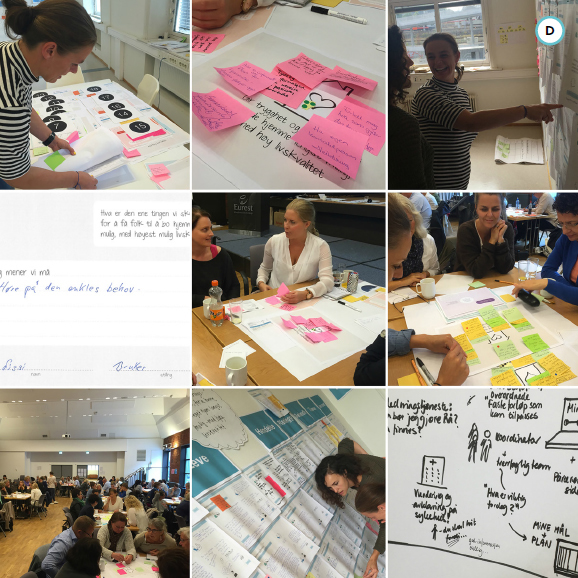
A set of nine service design principles was created to inform and guide delivery of future services.

“Putting the user at the center was definitely the right thing to do. It gives us the opportunity to truly work differently in the future, [to] accomplish major cost reductions at the same time as we improve the quality of the services and user experiences.”
— Bjørg Torill Madsen, Director and Project Lead, Nursing Home Agency, Oslo City Council
A future-proof plan with immediate benefits
Analyzing the impact of the pilot enabled us to make the projected savings analysis for future implementation. One pilot alone produced savings that covered the cost of the project. Of course, the significant financial savings are a big win – but just as importantly, the user experience was reported as being improved: a more considered, tailored approach to care that takes into account individual needs and respects individuals’ wishes.
We continue to support the client by attending stakeholder meetings where policy decisions are made about elderly care provision and presenting our project. The original pilot was done in three boroughs and the tools and methods developed are now being shared across the other boroughs that make up the Oslo municipal district.
Key Takeaways
01 Reducing costs doesn’t mean reducing quality of care.
02 Finding the balance between pragmatic solutions and utopian ideals requires patience.
03 Piloting (again and again) is key.
04 How you present your insights and proposals can be as important, if not more so, as the work itself. In this case, having “the numbers” (hard economic data) to back up our work was crucial.
05 The road from having a vision to implementation is long. We are continuing to support the client into the future of implementing services, after the project’s “close,” because we want to see them succeed.
1 The term “products” describes anything a company offers – no matter if this is tangible or not. In academia, products are often divided into goods and services. However, products are usually bundles of services and physical/digital products. As “goods” is colloquially understood as referring to something tangible, we prefer to speak of the term physical/digital products. Read more on this in the textbox Service-dominant logic in 2.5.
2 See 8.6.4, Case: Creating measurable business impact through piloting and implementing service design projects, for a great example of the crucial role of piloting in gathering hard economic data to support your service design work.
3 The importance of design doing, craft, and material knowledge for making is nicely described by Jon Kolko. See Design Thinking Foundations (2012, January 26). “Design Thinking vs. Design Doing,” at https://vimeo.com/35710033.
4 See 8.6.1, Case: Empowering employees for sustainable implementation of a service design project, for an example of how some of those key tactics can be successfully applied to achieve outstanding service.
5 Beck, K., et al. (2001) “Agile Manifesto,” at http://agilemanifesto.org.
6 Standish Group (1994). The chaos report. The Standish Group.
7 See http://www.growsmethod.com.
8 There’s an awesome German word for “entrepreneurial common sense”: Hausverstand.
9 Ries, E. (2011). The Lean Startup: How Today’s Entrepreneurs Use Continuous Innovation to Create Radically Successful Businesses. Crown Books.
10 Klement, A. (2013) “Replacing the User Story with the Job Story,” at https://jtbd.info/replacing-the-user-story-with-the-job-story-af7cdee10c27.
11 For an overview of prototyping methods see 7.2, Prototyping methods.
12 Hunt, A., & Thomas, D. (2000). The Pragmatic Programmer: From Journeyman to Master. Addison-Wesley Professional.
13 See Writing user stories in 5.3.
14 See 10 plus 10 in 6.4.
15 See Sh!tty first drafts in 10.3.4.
16 Read more about how to further plan and use prototyping in Chapter 7, Prototyping.
17 See 8.6.3, Case: Implementing service design in a software startup, for an example of how to implement the idea of an iterative process across your entire team.
18 Busuttil, J. (2015). The practitioner’s guide to product management. New York, NY: Grand Central Publishing. p.7.
19 Kumar, V. (2013). 101 Design Methods: A Structured Approach for Driving Innovation in Your Organization. Hoboken, NJ: John Wiley & Sons, p. 247.
20 Morris, L., Ma, M., & Wu, P. C. (2014). Agile Innovation: The Revolutionary Approach to Accelerate Success, Inspire Engagement and Ignite Creativity. Hoboken, NJ: John Wiley & Sons.
21 See 8.3, Service design and software development.
22 The service design approach should not be limited to your product management activities. See 8.6.2, Case: Implementing service design to create experiences, momentum, and results in sales, for an example of how design thinking and doing can transform the way your sales team engages with your customers.
23 Photo: Summer Design Summit/Florian Voggeneder.
24 Photo: Service Design Linz/Florian Voggeneder.
25 See http://www.cowoki.de.
26 Photo: COWOKI, Cologne.
27 Photo: IDEO.
28 Photo: Baupiloten, Berlin.
29 For more information about programming, see William M. Peña, W. M., & Parshall, S. A. (2012) Problem Seeking: An Architectural Programming Primer, 5th ed. John Wiley & Sons. See also Kumlin, R. R. (1995) Architectural Programming: Creative Techniques for Design Professionals, McGraw Hill Professional. And see Sanoff, H. (1977) Methods of Architectural Programming. Dowden, Hutchinson & Ross.
30 IDEO (n.d.) “Multistory Teaching Environment.” Retrieved September 9, 2015, from http://www.ideo.com/work/stanford-center-for-innovations-in-learning.
31 Cowan, S. E. (2010). “Democracy, Technocracy and Publicity: Public Consultation and British Planning, 1939-1951,” at http://www.escholarship.org/uc/item/2jb4j9cz.
32 Hofmann, S. (2015). Architecture Is Participation: Die Baupiloten: Methods and Projects. Jovis.
33 Hofmann, S. (2015). Architecture Is Participation: Die Baupiloten: Methods and Projects. Jovis.
34 Fritsch + Tschaidse Architects, Munich.
35 Photo: HfG Schwäbisch Gmünd, in cooperation with Deutsche Telekom, Germany.
36 Photo: Baupiloten, Berlin.
37 Photo: Fritsch + Tschaidse Architects, Munich.
38 Find out more at http://designcouncil.org.uk.
39 The legal situation has since changed, and crowdfunding and crowd investing are now becoming popular in Austria.
40 Four years later, we are a team of 20.
41 In 2012/2013, we described the value proposition of Smaply as “Create professional journey maps in minutes.” We described the user need we tried to fulfill as “Users need to quickly create presentable journey maps and be able to change these when they iterate with geographically dispersed teams.” As our core target groups we defined “agencies and companies doing service design.”
42 Polli, R., & Cook, V. (1969). “Validity of the Product Life Cycle.” The Journal of Business, 42(4), 385.
